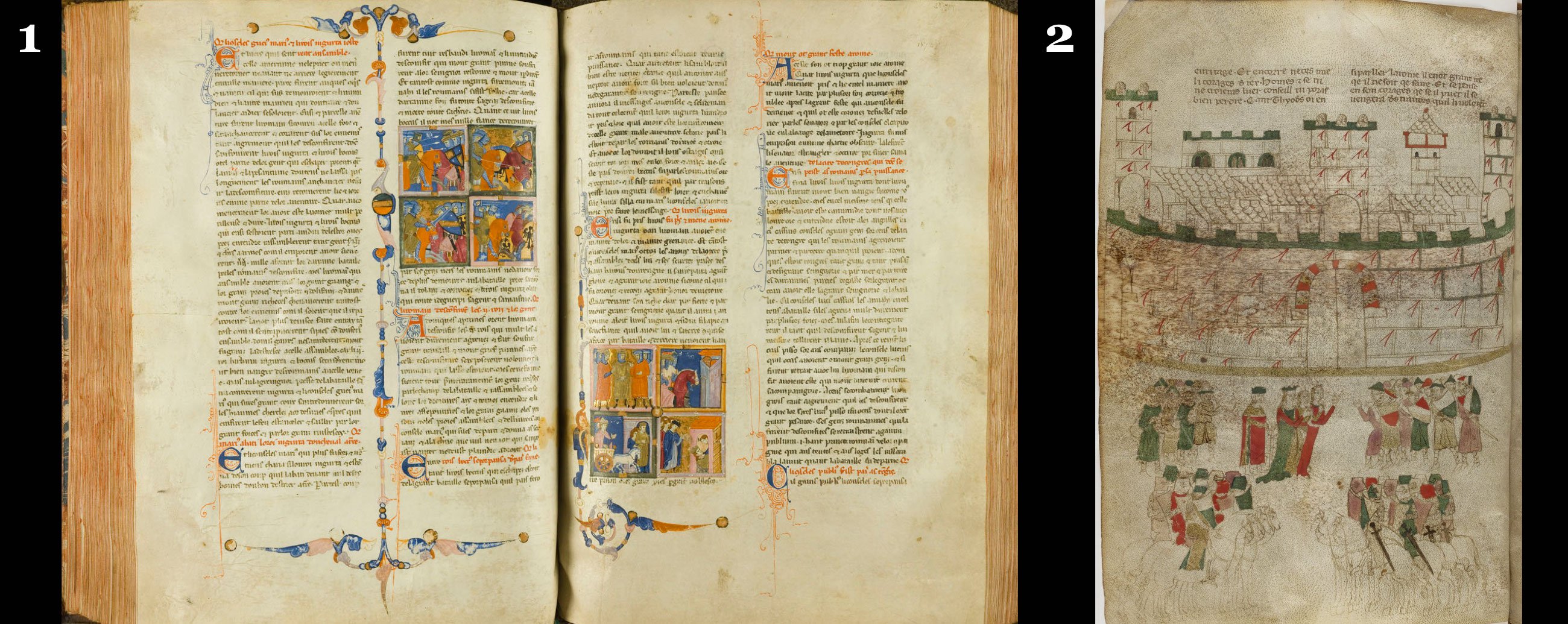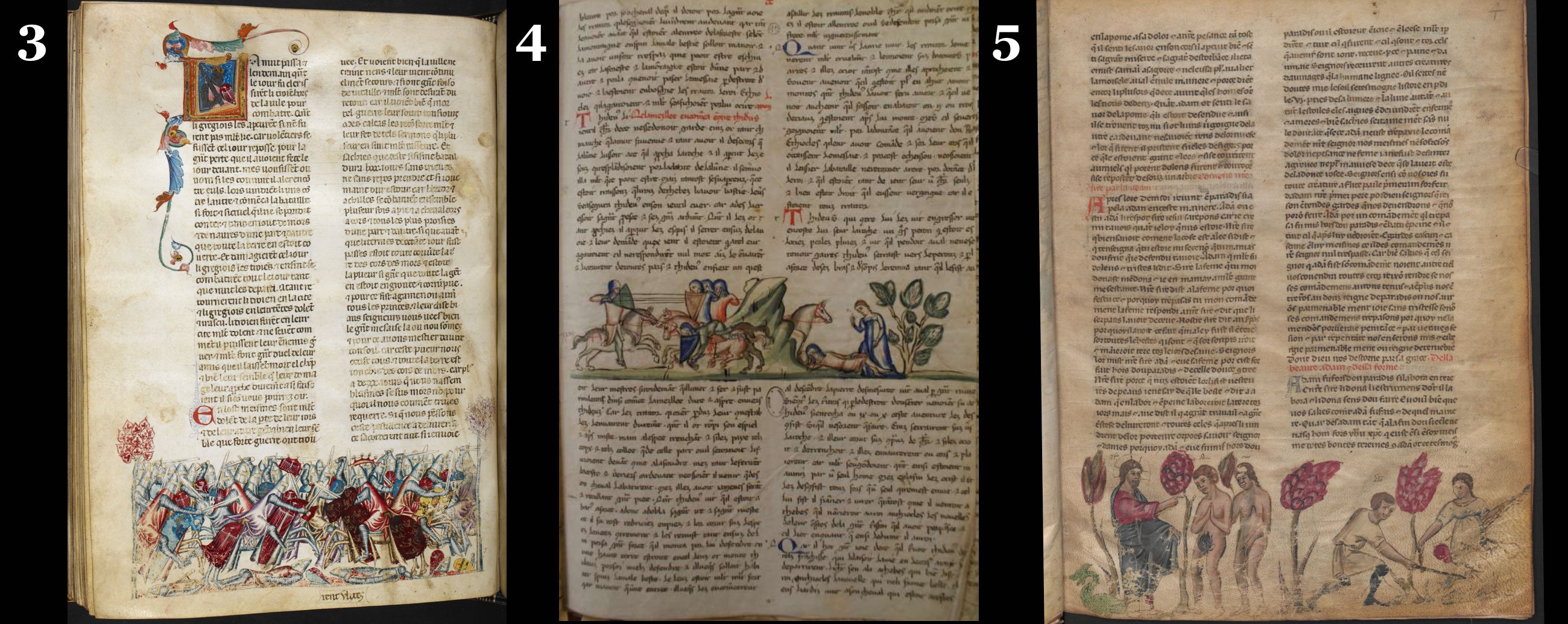A crucial episode in the history of medieval book illustration: The Histoire ancienne in Italy
Rosa M. Rodríguez Porto, an art historian by training, has extensively worked on medieval book illumination, on medieval Iberian courtly culture and on the Classical tradition in the Middle Ages. Rosa will be speaking at our international conference in June 2019. For more info see our events page.
I would like to begin by expressing my gratitude to the TVOF team, since it was their invitation to take part in a workshop about the Histoire ancienne jusqu’à César (hereafter HAC) last March that gave me the chance to go back to my work on the illustrated copies of this historical compilation, which was widely disseminated from its native Flanders to the Holy Land and Italy. The feature that contributed most decisively to the enduring allure of this textual tradition was the inclusion—from very early on and in more than half of the preserved copies of the text—of lengthy pictorial cycles supplementing the narrative. As such, the place of the HAC in the consolidation of a lay readership and of the illustrated history book in the Middle Ages cannot go understated, as argued already by Hugo Buchthal in his study on the beginnings of ‘secular illustration’. The equally important role of the HAC in the development of new layouts and pictorial systems in Northern France and Outremer has been highlighted in recent decades as well. And yet, as I contended in the aforementioned workshop, a sustained inquiry into the illuminated copies produced in Italy in the late Ducento and the Trecento may shed new light on the reception of the HAC outside the Franco-Flemish area and, most crucially, on the dynamics governing late medieval historiographical writing and illustration as a whole.

Fig 1. Chantilly, Musée Condé MS 726, fols. 164-165r (Naples? c. 1272-1278). Source: BVMM.
Fig. 2: Paris, BnF, Fr. 1386, fol. 15v (Genoa, c. 1284-1310). Source: Gallica.bnf.fr.
This initial formulation of my ideas has led to a new research project that will be developed next year, when I will spend two months working in Florence as visiting fellow at the Fondazione Ezio Franceschini. My underlying assumption is that, despite the critical attention traditionally paid by philologists and art historians alike to the so-called noyau ancien of the HAC, it was in Italy that the most substantial conceptual changes to this manuscript and pictorial tradition were to take place roughly between 1270 and 1400:
1) As already noticed by Marc-René Jung, some of these Italian witnesses exhibit a distinctive pattern of textual clustering around pagan history, from the initial pairing of the HAC with the Fait des Romains in the luxurious copy made for Charles I of Anjou (Fig. 1) to the progressive elimination of the biblical sections in Genovese copies (Fig. 2) made at the end of the 13th century, which paved the way for the second redaction of the text at the court of Robert I in Naples (Fig. 3) and its re-elaboration of the Trojan section based on the Roman de Troie and Ovid’s Heroides;
2) in contrast to the exclusively aristocratic circles among which the text had circulated in Flanders and the Holy Land, it was in Italy too where the HAC was able to reach a wider audience of merchants and members of the urban elite, by means of, first, the semi-industrial production of relatively cheap copies in Genoa and, later, of more luxurious manuscripts for the local patriciate of the Veneto and the Emilia (Fig. 4), of which one has recently been rediscovered in the Archivio di Stato di Modena by Vicenzo Cassì;
3) in addition to this significant diversification in terms of book format, another profound transformation took place with the Neapolitan manuscript of the second redaction of the HAC, since its 301 miniatures constituted an extraordinary visual amplification in comparison to the more restrained iconographic cycles of its Flemish and Crusader precedents. As Fritz Saxl suggested long ago, this immersive pictorial account created in the wake of the art of Giotto and his followers would have certainly stirred an intense emotional response in its readers, even if the consequences of this figurative revolution are only now just beginning to be explored in the realm of book illustration by Costanza Cipollaro and Marilynn Desmond.
By underscoring the connections among phenomena geographically and chronologically far apart that otherwise would go unnoticed, this panoramic survey of the Italian reception of the HAC aims at reconstructing the visual fabric created by these manuscripts, both texts and images, cherished by an ever-changing audience throughout time. But, in order to better understand how the past was imagined in the pages of this ‘Biblia cum Troianorum Romanorumque gestibus compilata’ (De Vulgari Eloquentia, I X 2) [‘Bible compiled with the deeds of the Trojans and Romans’], as Dante once defined the HAC, it will also be necessary to examine the images illustrating other works with which this compilation would have woven a dense web of intertextual and intervisual links. These include, among many others, Benoît de Sainte-Maure’s Roman de Troie (c. 1165), Guido delle Colonne’s Historia destructionis Troiae (c. 1287), the anonymous Excidium Troiae (6th or 7th c.) and the late-antique works by Dares and Dyctis for the Trojan section; Godfrey of Viterbo’s Pantheon and the Multae historiae romanorum for the chapters on Roman history; not to speak of the multiple visual sources that could have inspired the visualization of Old Testament episodes, in different media such as mural paintings, ivories and mosaics. In this regard, the Genesis narrative of Cod. 2576 of the ÖNB (Fig. 5) made in Venice c. 1330 and inspired by the mosaic cycle in S. Marco’s narthex is but a case in point.
Only from this transdisciplinary perspective would it be possible to accomplish the ultimate goal of my inquiry: to define the way in which images were able to articulate, and sometimes contest, the generic and discursive conventions endorsed by the texts they translated into images, above all those modulating the distinction between estoire and fable, sacred and pagan history. In fact, depending on the diverse format, luxury and nature of pictorial cycles devised for these manuscripts, the text of the HAC may have been perceived as dynastic history (as in Fig. 3), romance (as in Figs. 2 and 4), or leaning towards the side of sacred history (as in Fig. 5).

Fig. 3: London, BL, Royal 20 D. I., fol. 98v (Naples, c. 1330-1340). Reproduced with permission from the British Library Board. Available to consult online.
Fig. 4: Modena, Archivio di Stato, Frammenti, busta 11/a, fasc. 7, c. 10 (Bologna, c. 1360-1370). Reproduced with permission from the Archivio di Stato di Modena.
Fig. 5: Vienna, ÖNB, Cod. 2576, fol. 4r (Venice, c. 1330). Source: ÖNB website.
Rosa Maria Rodríguez Porto
Selected bibliography:
H. Buchthal, Historia Troiana: Studies in the History of Mediaeval Secular Illustration (London, The Warburg institute, 1971).
V. Cassì, ‘I codici estensi dell’Histoire ancienne jusqu’à César’, Annali online di Ferrara – lettere, VIII/1 (2013): 38-141.
C. Cipollaro, ‘Invenzione e reinvenzione negli esemplari miniati dal Roman de Troie tra Francia e Italia: Dal ambrosiano D 55 Sup, al Cod. 2571 di Vienna’, in Allen Mären ein Herr: ritterliches Troja in illuminierten Handschriften = Lord of all tales: Chivalric Troy in illuminated manuscripts, ed. by C. Cipollaro and M. V. Schwarz (Vienna: Böhlau, 2017), pp. 19-66.
M. Desmond, ‘Translatio imperii and the Matter of Troy in Angevin Naples: BL Royal MS 20 D I and Royal MS 6 E IX’, Italian Studies, 72/2 (2017): 177-191.
M.-R. Jung, La legende de Troie en France au Moyen Âge: Analyse des versions françaises et bibliographie raisonnée des manuscrits (Basel-Tübingen: Francke, 1996).
R. M. Rodríguez Porto, ‘Beyond the Two Doors of Memory. Intertextualities and Intervisualities in Thirteenth-century Illuminated Manuscripts of the Roman de Troie and the Histoire Ancienne’, in Memory and Commemoration in Medieval Culture, ed. by E. Brenner, M. Cohen and M. Franklin-Brown (Aldershot: Ashgate, 2013), pp. 55-76.
—, ‘Imagines Historiarum: Visions of the Past in Medieval Illuminated Manuscripts’, in The Medieval World (2nd ed.) ed. by P. Linehan and M. Costambeys (Abingdon: Routledge, 2018), pp. 177-94.
F. Saxl, ‘The Troy Romance in French and Italian Art’, in Lectures (London: The Warburg Institute, 1957), vol. II, pp. 125-38.